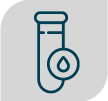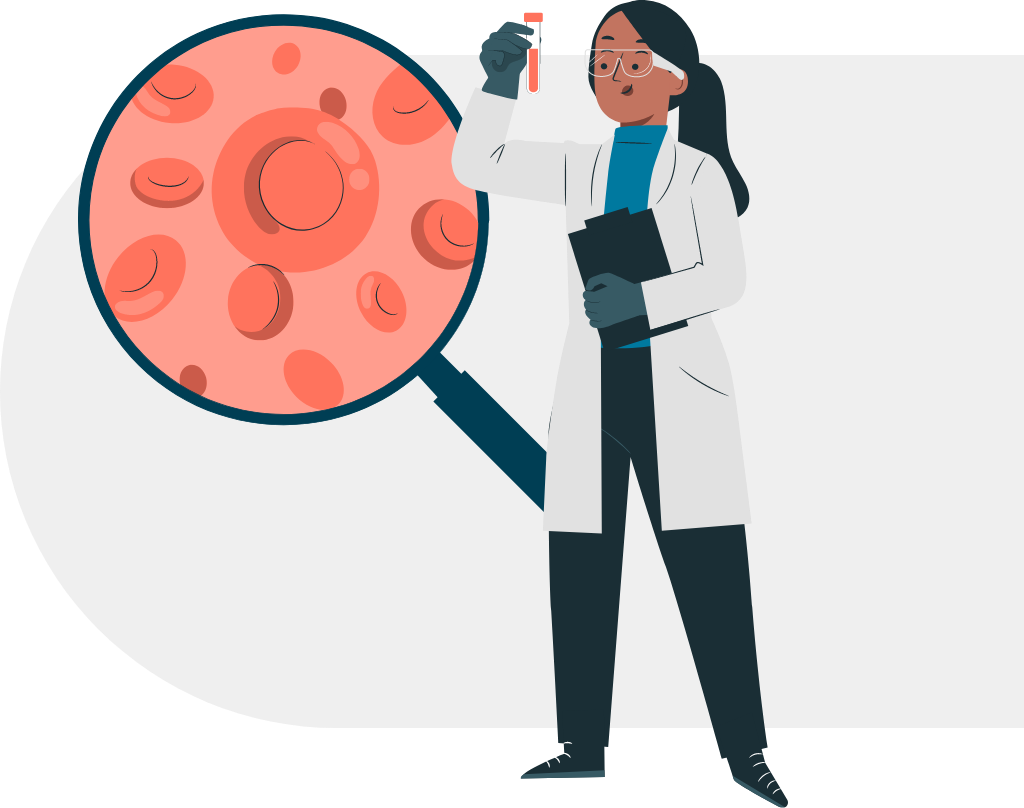Ruta de atención y exámenes de diagnostico
El diagnóstico de la trombocitopenia inmunitaria suele requerir varios análisis de sangre. Es posible que el proveedor de atención médica te remita a un especialista en enfermedades de la sangre, conocido como hematólogo.

¿Cómo se diagnostica la TPI?
La TPI es un diagnóstico de exclusión. El médico descartará otras posibles causas de plaquetas bajas, como enfermedades subyacentes o medicamentos que usted o su hijo estén tomando. Además de revisar el historial médico, el médico realizará un examen físico y pruebas médicas para confirmar el diagnóstico de TPI, como:

Hemograma completo (CBC)
Esta prueba mide el recuento de plaquetas y el número de otras células sanguíneas en la sangre.

Análisis de médula ósea
Estas pruebas comprueban si su médula ósea está sana. Es posible que necesite esta prueba para confirmar que padece TPI y no otro trastorno plaquetario.
También es posible que se realice un análisis de sangre para detectar anticuerpos que ataquen a las plaquetas, y si hay riesgo de VIH, hepatitis C o Heliobacter pylori, el médico puede hacer pruebas de detección de estas infecciones que podrían estar relacionadas con la TPI. En casos excepcionales, los médicos pueden tomar una pequeña muestra de médula ósea (biopsia de médula ósea) para determinar el nivel de producción de plaquetas en el cuerpo2.

Frotis de sangre:
En esta prueba se coloca una muestra de sangre en un portaobjetos. Se utiliza un microscopio para observar las plaquetas.

¿Se puede curar la TPI?

Aunque no existe una cura para la TPI, muchos pacientes han experimentado mejoras en su recuento de plaquetas después del tratamiento. Para otros, el efecto no es duradero, por lo que necesitan pasar a otra clase de fármacos, como los agonistas del receptor de la trombopoyetina (AR-TPO) o un anticuerpo monoclonal. Se ha demostrado que ambos aumentan las plaquetas, aunque no todo el mundo responde a ninguno de los dos tratamientos. La enfermedad puede entrar en remisión durante un largo período de tiempo, incluso durante el resto de la vida, pero también puede reaparecer3.
Referencias
1.Bennett, C. M., Neunert, C., Grace, R. F., Buchanan, G., Imbach, P., Vesely, S. K., & Kuhne, T. (2018). Predictors of remission in children with newly diagnosed immune thrombocytopenia: Data from the Intercontinental Cooperative ITP Study Group Registry II participants. Pediatric blood & cancer, 65(1), 10.1002/pbc.26736. https://doi.org/10.1002/pbc.26736
2.Bussel, J. B., Arnold, D. M., Boxer, M. A., Cooper, N., Mayer, J., Zayed, H., Tong, S., & Duliege, A. M. (2019). Long-term fostamatinib treatment of adults with immune thrombocytopenia during the phase 3 clinical trial program. American journal of hematology, 94(5), 546–553. https://doi.org/10.1002/ajh.25444
3.James B. Bussel, Waleed Ghanima, Yoshiaki Tomiyama, Donald M. Arnold, Drew Provan, Ming Hou, Cristina Santoro, Serge Laborde, Alexandra Kruse, Caroline Kruse, Mervyn Morgan, Barbara Lovrencic, John Waller, Jens Haenig, Nichola Cooper; Physicians' and Patients' Perspectives on Treatments in ITP - a Multi-Country Perspective: Results from the ITP World Impact Survey (I-WISh). Blood 2019; 134 (Supplement_1): 1097. doi: https://doi.org/10.1182/blood-2019-130591
4.Chaturvedi, S., Arnold, D. M., & McCrae, K. R. (2018). Splenectomy for immune thrombocytopenia: down but not out. Blood, 131(11), 1172–1182. https://doi.org/10.1182/blood-2017-09-742353
5.Cheng, Y., Wong, R. S., Soo, Y. O., Chui, C. H., Lau, F. Y., Chan, N. P., Wong, W. S., & Cheng, G. (2003). Initial treatment of immune thrombocytopenic purpura with high-dose dexamethasone. The New England journal of medicine, 349(9), 831–836. https://doi.org/10.1056/NEJMoa030254
6.Cines, D. B., & Bussel, J. B. (2005). How I treat idiopathic thrombocytopenic purpura (ITP). Blood, 106(7), 2244–2251. https://doi.org/10.1182/blood-2004-12-4598
7.Coutinho, A. E., & Chapman, K. E. (2011). The anti-inflammatory and immunosuppressive effects of glucocorticoids, recent developments and mechanistic insights. Molecular and cellular endocrinology, 335(1), 2–13. https://doi.org/10.1016/j.mce.2010.04.005
8.Davies, J. M., Lewis, M. P., Wimperis, J., Rafi, I., Ladhani, S., Bolton-Maggs, P. H., & British Committee for Standards in Haematology (2011). Review of guidelines for the prevention and treatment of infection in patients with an absent or dysfunctional spleen: prepared on behalf of the British Committee for Standards in Haematology by a working party of the Haemato-Oncology task force. British journal of haematology, 155(3), 308–317. https://doi.org/10.1111/j.1365-2141.2011.08843.x
9.Ghanima, W., Cooper, N., Rodeghiero, F., Godeau, B., & Bussel, J. B. (2019). Thrombopoietin receptor agonists: ten years later. Haematologica, 104(6), 1112–1123. https://doi.org/10.3324/haematol.2018.212845
10.Jurczak, W., Chojnowski, K., Mayer, J., Krawczyk, K., Jamieson, B. D., Tian, W., & Allen, L. F. (2018). Phase 3 randomised study of avatrombopag, a novel thrombopoietin receptor agonist for the treatment of chronic immune thrombocytopenia. British journal of haematology, 183(3), 479–490. https://doi.org/10.1111/bjh.15573
11.Kelly, K., Gleeson, M., & Murphy, P. T. (2009). Slow responses to standard dose rituximab in immune thrombocytopenic purpura. Haematologica, 94(3), 443–445. https://doi.org/10.3324/haematol.2008.001396
12.Khellaf, M., Charles-Nelson, A., Fain, O., Terriou, L., Viallard, J. F., Cheze, S., Graveleau, J., Slama, B., Audia, S., Ebbo, M., Le Guenno, G., Cliquennois, M., Salles, G., Bonmati, C., Teillet, F., Galicier, L., Hot, A., Lambotte, O., Lefrère, F., Sacko, S., … Godeau, B. (2014). Safety and efficacy of rituximab in adult immune thrombocytopenia: results from a prospective registry including 248 patients. Blood, 124(22), 3228–3236. https://doi.org/10.1182/blood-2014-06-582346
13.Kuter, D. J., Bussel, J. B., Newland, A., Baker, R. I., Lyons, R. M., Wasser, J., Viallard, J. F., Macik, G., Rummel, M., Nie, K., & Jun, S. (2013). Long-term treatment with romiplostim in patients with chronic immune thrombocytopenia: safety and efficacy. British journal of haematology, 161(3), 411–423. https://doi.org/10.1111/bjh.12260
14.Leone, G., & Pizzigallo, E. (2015). Bacterial Infections Following Splenectomy for Malignant and Nonmalignant Hematologic Diseases. Mediterranean journal of hematology and infectious diseases, 7(1), e2015057. https://doi.org/10.4084/MJHID.2015.057
15.Lucchini, E., Palandri, F., Volpetti, S., Vianelli, N., Auteri, G., Rossi, E., Patriarca, A., Carli, G., Barcellini, W., Celli, M., Consoli, U., Valeri, F., Santoro, C., Crea, E., Vignetti, M., Paoloni, F., Gigliotti, C. L., Boggio, E., Dianzani, U., Giardini, I., … for Gruppo Italiano Malattie Ematologiche dell’Adulto (GIMEMA) (2021). Eltrombopag second-line therapy in adult patients with primary immune thrombocytopenia in an attempt to achieve sustained remission off-treatment: results of a phase II, multicentre, prospective study. British journal of haematology, 193(2), 386–396. https://doi.org/10.1111/bjh.17334
16.McCrae K. (2011). Immune thrombocytopenia: no longer 'idiopathic'. Cleveland Clinic journal of medicine, 78(6), 358–373. https://doi.org/10.3949/ccjm.78gr.10005
17.Neunert, C., Terrell, D. R., Arnold, D. M., Buchanan, G., Cines, D. B., Cooper, N., Cuker, A., Despotovic, J. M., George, J. N., Grace, R. F., Kühne, T., Kuter, D. J., Lim, W., McCrae, K. R., Pruitt, B., Shimanek, H., & Vesely, S. K. (2019). American Society of Hematology 2019 guidelines for immune thrombocytopenia. Blood advances, 3(23), 3829–3866. https://doi.org/10.1182/bloodadvances.2019000966
18.Immune Thrombocytopenia (ITP) | NHLBI, NIH. (2022, March 24). NHLBI, NIH. https://www.nhlbi.nih.gov/health/immune-thrombocytopenia
19.Immune Thrombocytopenia (ITP) | NHLBI, NIH. (2022, March 24). NHLBI, NIH. https://www.nhlbi.nih.gov/health/immune-thrombocytopenia
20.Immune thrombocytopenia - Symptoms, causes, treatment | NORD. (2022, July 12). National Organization for Rare Disorders. https://rarediseases.org/rare-diseases/immune-thrombocytopenia/
21.Product Information Nplate-Amgen (n.d). Nplate, INN-romiplostim (europa.eu)
22.Patel, V. L., Mahévas, M., Lee, S. Y., Stasi, R., Cunningham-Rundles, S., Godeau, B., Kanter, J., Neufeld, E., Taube, T., Ramenghi, U., Shenoy, S., Ward, M. J., Mihatov, N., Patel, V. L., Bierling, P., Lesser, M., Cooper, N., & Bussel, J. B. (2012). Outcomes 5 years after response to rituximab therapy in children and adults with immune thrombocytopenia. Blood, 119(25), 5989–5995. https://doi.org/10.1182/blood-2011-11-393975
23.Product Information Promacta-Novartis (2019)
24.Provan, D., Stasi, R., Newland, A. C., Blanchette, V. S., Bolton-Maggs, P., Bussel, J. B., Chong, B. H., Cines, D. B., Gernsheimer, T. B., Godeau, B., Grainger, J., Greer, I., Hunt, B. J., Imbach, P. A., Lyons, G., McMillan, R., Rodeghiero, F., Sanz, M. A., Tarantino, M., Watson, S., … Kuter, D. J. (2010). International consensus report on the investigation and management of primary immune thrombocytopenia. Blood, 115(2), 168–186. https://doi.org/10.1182/blood-2009-06-225565
25.Provan, D., Arnold, D. M., Bussel, J. B., Chong, B. H., Cooper, N., Gernsheimer, T., Ghanima, W., Godeau, B., González-López, T. J., Grainger, J., Hou, M., Kruse, C., McDonald, V., Michel, M., Newland, A. C., Pavord, S., Rodeghiero, F., Scully, M., Tomiyama, Y., Wong, R. S., … Kuter, D. J. (2019). Updated international consensus report on the investigation and management of primary immune thrombocytopenia. Blood advances, 3(22), 3780–3817. https://doi.org/10.1182/bloodadvances.2019000812
26.Product Information Revolade-Novartis (n,d).
27.Product Information MabThera-Roche (n,d).
28.SA Advisory Group on Antimicrobial Resistance [SAAGAR]. (2019). Splenectomy vaccination and Antimicrobial Prophylaxis (Adult asplenic and hyposplenic patients) Clinical Guideline.
29.Schifferli, A., Holbro, A., Chitlur, M., Coslovsky, M., Imbach, P., Donato, H., Elalfy, M., Graciela, E., Grainger, J., Holzhauer, S., Riccheri, C., Rodeghiero, F., Ruggeri, M., Tamary, H., Uglova, T., Wu, R., Kühne, T., & Intercontinental Cooperative ITP Study Group (ICIS) (2018). A comparative prospective observational study of children and adults with immune thrombocytopenia: 2-year follow-up. American journal of hematology, 93(6), 751–759. https://doi.org/10.1002/ajh.25086
30.Trivin, C., Tran, A., Moulin, B., Choukroun, G., Gatault, P., Courivaud, C., Augusto, J. F., Ficheux, M., Vigneau, C., Thervet, E., & Karras, A. (2017). Infectious complications of a rituximab-based immunosuppressive regimen in patients with glomerular disease. Clinical kidney journal, 10(4), 461–469. https://doi.org/10.1093/ckj/sfw101
31.van der Kolk, L. E., Baars, J. W., Prins, M. H., & van Oers, M. H. (2002). Rituximab treatment results in impaired secondary humoral immune responsiveness. Blood, 100(6), 2257–2259.
Novartis de Colombia S.A. Calle 93B No. 16-31. PBX 654 44 44. Bogotá, D.C. Novartis Pharma, AG de Basilea, Suiza. ®️ = Marca registrada. Material dirigido a público general. Más información en el Departamento Médico de Novartis S.A Colombia: 6544444 o al correo electrónico: [email protected]. Si desea reportar un evento adverso ingrese al siguiente link: https://www.report.novartis.com/es o a través del correo electrónico: [email protected]. Este material no es promocional en lenguaje, apariencia o intención. Si se hace alusión a productos o indicaciones no aprobados por la autoridad regulatoria del país, será bajo el estricto propósito educativo, de genuino intercambio científico y para incluir las alternativas de tratamiento de forma balanceada, completa y vigente. Este material no pretende sustituir o reemplazar una decisión clínica ni terapéutica. No se autoriza la grabación, toma de fotografías y distribución del material y tampoco difusión por medios no autorizados por Novartis. Fecha de aprobación: 19/09/2024. Fecha de caducidad: 19/09/2026 Id del contenido: FA-11278450